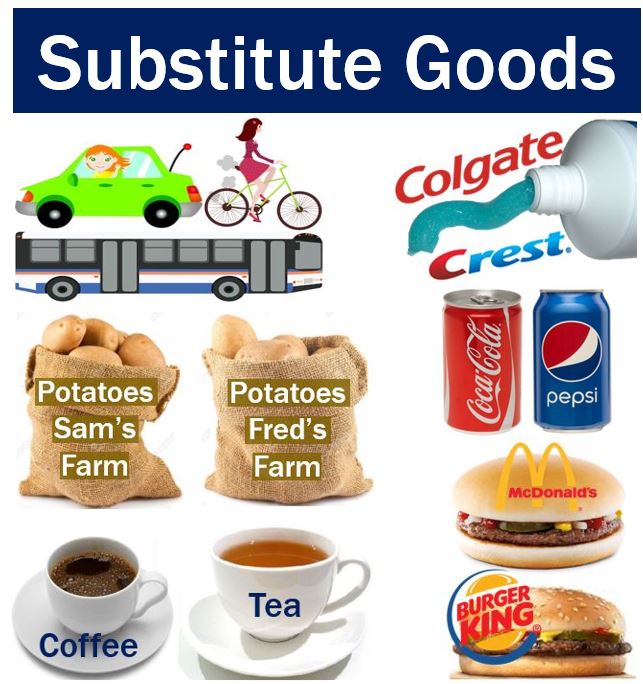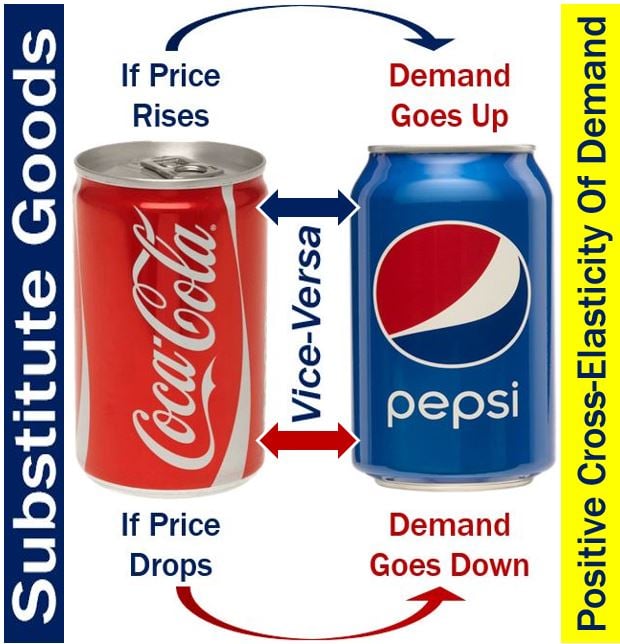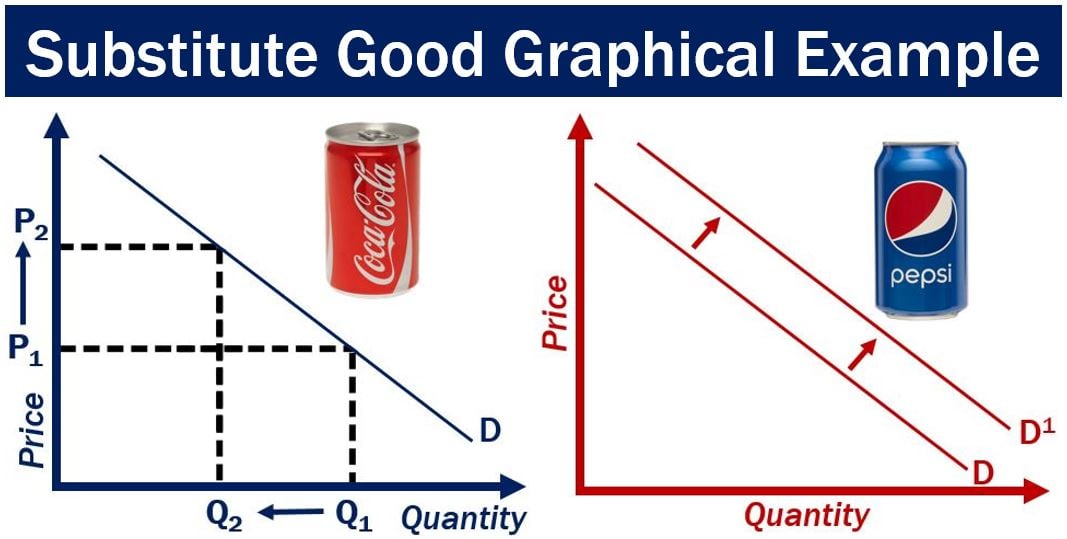What are substitute goods? Definition and meaning
Substitute Goods or Substitutes are at least two products that could be used for the same purpose by the same consumers.
If the price of one of the products rises or falls, then demand for the substitute goods or substitute good (if there is just one other) is likely to increase or decline. The other products – the substitutes – have a positive cross-elasticity of demand.
The availability and accessibility of substitutes can significantly influence consumer loyalty and purchasing patterns, as buyers readily switch to alternatives when faced with price changes or supply constraints.
Substitute goods are identical, similar, or comparable to another product, in the eyes of the consumer.
Substitute goods can either fully or partly satisfy the same needs of the customers. Therefore, they can replace one another, so the consumer believes.
Pepsi-Cola is a substitute good for Coca-Cola, and vice-versa. When the price of Coca-Cola goes up, demand for Pepsi-Cola will subsequently rise (if Pepsi does not raise its price).
According to the Cambridge Dictionary, substitute goods are:
“Products that can satisfy some of the same customer needs as each other. Butter and margarine are classic examples of substitute goods.”
If someone doesn’t have access to a car they can travel by bus or bicycle. Buses or bicycles, therefore, are substitute goods for cars. Substitute goods are two or more products that the consumer can use for the same purpose.

Examples of substitute goods
Below is a list of some common substitute goods:
- Coke & Pepsi
- McDonald’s & Burger King
- Colgate & Crest (toothpaste)
- Tea & Coffee
- Butter & Margarine
- Kindle & Books Printed on Paper
- Fanta & Crush
- Potatoes in one Supermarket & Potatoes in another Supermarket.
- Streaming Services (Netflix & Hulu or Amazon Prime)
- Electric cars & Gasoline Cars
- Soy milk & Almond Milk
McDonald’s and Burger King’s hamburgers both satisfy the consumer’s requirements of being served rapidly and relatively cheaply.
The price of Burger King’s hamburgers has a direct effect on demand for those of McDonald’s, and vice-versa. They satisfy the positive cross-elasticity component of demand for substitute goods.
If one product responds immediately to a change in price to another – if demand rises by the same percentage as the others’ price increase – it is a ‘perfect substitute’ or ‘close substitute.’ If the cross-elasticity is slight – if a 20% increase in the price of one leads to just a 1% rise in demand for another – it is known as a ‘weak substitute.’

The definition of a ‘perfect substitute’ is all down to the preference of the consumer. If I receive the same satisfaction from Coke as I do from Pepsi, they are perfect substitutes. If you think one tastes better than the other, then Pepsi is a ‘near-perfect substitute’ for Coke, or vice-versa.
Direct and indirect competition
Close substitute goods are in indirect competition, i.e., they are similar products that target the same customer group and satisfy the same needs.
For example, a frozen yogurt shop and an ice cream shop sell different goods. However, they both target people who are hungry and want something sweet and cold. Therefore, they are in indirect competition. They are indirect competitors.
A frozen yogurt shop sells the same goods as another frozen yogurt shop nearby. They are in direct competition. They are direct competitors.
Similarly, online marketplaces and traditional brick-and-mortar stores often find themselves in indirect competition, as both aim to satisfy the consumer’s desire for convenient shopping experiences, albeit through different mediums.
Substitute goods and monopolistic competition
In several markets for commonly-purchased goods, some products are perfectly substitutable yet are branded and marketed differently. We refer to this condition as monopolistic competition.

Imagine that the price of a can of Coke increases from P1 to P2. People would consume less Coke – the quantity declines from Q1 to Q2. For a can of Pepsi – the substitute good – the demand curve shifts out for all price levels, from D to D1, leading to a greater consumption of the substitute good. (Image: adapted from Wikipedia)
Let’s consider, for example, the comparison between a name brand and generic version of a medication. The two products may be identical, they have the same **active ingredient – they are substitute goods. However, their packaging is quite different.
** The active ingredient is the part of a compound or substance that produces its biological or chemical effect. In other words, it treats, relieves, or cures the patient’s illness or condition.
As the two goods are essentially identical, the only genuine difference between the two medications is the price. In other words, the two vendors depend mainly on branding and price respectively to achieve sales.
The Five Forces
Substitute goods are one of the Five Forces. The other four are:
- existing customers,
- new customers,
- barriers to entry, and
- suppliers.
The five forces are external factors that tell us how viable, i.e., how profitable, an industry is. When a business is viable, we expect it to make a profit year after year.
The proliferation of digital platforms and e-commerce has introduced virtual goods and services as substitutes, significantly influencing consumer choices and market dynamics.
This evolution in consumer behavior underscores the importance of technological adaptability for businesses seeking to remain competitive in an increasingly digital marketplace.
Video – What are Substitute Goods?
This video, from our sister channel on YouTube – Marketing Business Network, explains what ‘Substitute Goods’ are using simple and easy-to-understand language and examples.

